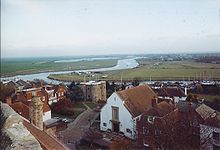Rye, East Sussex
| Rye | |
|---|---|
| Population | Expression error: "4,600 (2001 census)" must be numeric |
| OS grid reference | TQ918205 |
| District | |
| Shire county | |
| Region | |
| Country | England |
| Sovereign state | United Kingdom |
| Post town | RYE |
| Postcode district | TN31 |
| Dialling code | 01797 |
| Police | Sussex |
| Fire | East Sussex |
| Ambulance | South East Coast |
| UK Parliament | |
Rye is a small hill top town and civil parish in East Sussex, England, on the River Rother, and at the western edge of the Walland Marsh, part of the Romney Marshes.
The town's economy relies heavily on tourism because of its historical importance.
Notable buildings in the town include St Mary's parish church, the Ypres Tower, Lamb House and many of the houses on Mermaid Street, Watchbell Street, and Church Square.
History

- Rye received its first town charter under the Normans; and was fortified during the reign of King Stephen
- Although not one of the original Cinque Ports, Rye had become one by the 13th century, providing nine ships to the federation
- Rye lost its importance as a port when the coastline changed as a result of storms and long shore drift, and the town is now two miles (3.2 km) from the sea. It still has some trade and fish caught in Rye Bay is landed daily and sold from the quayside.
- Sir Robert Naunton mentions it as the first place he visited in his book Travels in England, published sometime between 1628 and 1632. Daniel Defoe and William Cobbett also mention the town in the course of their travels.
- Sir Anthony van Dyck did several drawings of the town, unusually detailed for him, and probably done to pass the time until a ship to the Continent arrived.
- HMS Rye, a Royal Navy minesweeper, was named for the town during the Second World War.
The city of Rye is also known from the song "Thae Mary Stanford of Rye" by William Pint & Felicia Dale, which refers to a lifeboat lost off Hastings and Rye.
Famous residents
Although not consciously a "writers' colony", Rye has produced and attracted many writers.
Lamb House, one of the town's historic residences and now owned by the National Trust, has been home to:
- Henry James (1843 – 1916), American novelist, resident 1898 to 1916.
- E.F. Benson (1867 – 1940), English novelist. House and town feature prominently in his "Mapp and Lucia" novels, as Mallards House and Tilling.
- Rumer Godden (1907 – 1998), Anglo-Indian novelist.
Other residents of the town and environs include:
- John Fletcher (1579-1625), Jacobean playwright and solicitor.
- Radclyffe Hall (1880 – 1943), seminal lesbian writer.
- Russell Thorndike (1885-1972), who set his Dr Syn novels about smuggling on the marshes.
- Conrad Aiken (1889 – 1973), American writer.
- Joan Aiken (1924 – 2004), children's author, daughter of Conrad Aiken.
- Philippa Urquhart (1940 – ), British actress.
- Monica Edwards (1912 – 1998), children's author who lived at Rye Harbour and set her Romney marsh novels in the area, renaming Rye Dunsford.
- John Christopher (b.1922), science fiction author. The 1980s British television series based on his trilogy, The Tripods, was filmed near his house.
- John Ryan (b.1921), Although born in Edinburgh, this British Author/Cartoonist famed for his TV cartoon Captain Pugwash, is a resident of Rye.
- Malcolm Saville (1901-82), author of nearly 80 children's books, largely thrillers and adventure stories. Saville was the creator of the Lonely Pine series of books, a number of which were set in Rye, including The Gay Dolphin Adventure and Rye Royal.
Communications

Road
Rye stands on the A259 coast road.
Bus
The 711 Stagecoach Bus runs from Dover to Hastings (and Hastings to Dover) via Rye hourly.
Rail
Rye has a railway station on the Brighton to Ashford, Kent "Marshlink" line. It was also the terminus for the pre-World War II Rye & Camber Tramway, built to serve golf courses and Camber Sands, a tourist beach.
It also has rail links to London via Ashford or Hastings. There are no direct services however.
Walks
The Saxon Shore Way starts at Gravesend, Kent and traces the coast as it was in Roman times, via Rye, as far as Hastings, East Sussex, 163 miles (262 km) in total.
References
External links
- Rye Web Site Tourism and Community Town site
- Rye Castle Museum Local history
- Rye pictures & information
- Lamb House information at the National Trust
- History, Geology, Maps, Geography and Tourist Information on the area
- Rye Farmers' Market
- Rye Harbour Boating and mooring information
